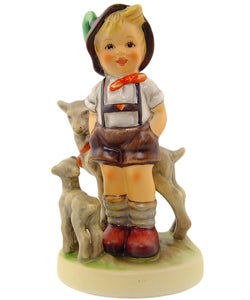Hummel
Rosy-cheeked, dimple-kneed, tow-headed little porcelain golems.
Prime Requisite: CHA
Saves and XP Progression as Fighters.
Armor: Hummels can wear armor, but is must be comically too large for them, causing them to subtract the AC value of the armor from any DEX checks.
Due to their short stature, Hummels receive +2 AC vs. Large opponents.
Polarizing Reaction: Hummels do not have gradated reaction rolls. Roll 2d6 + CHA bonus. Any result over 6 is “Willingly helps/protects” and under is “Attacks immediately.”
Baby Animals: A Hummel can charm 1 baby animal (including baby monsters) per Level.
Big Tears: Upon taking damage, a Hummel can plop onto their bottom and shed a single, impossibly large tear. It hangs there, quivering, reflecting the attacker’s visage back at them and making them question the choices that have brought them to this act of cruelty. Save vs. Paralysis, or be caught in state of guilt and doubt until the Hummel moves or blinks, finally shedding the tear.
Hollow Inside: In the heat of battle, Hummels may relax their adorable façade, and reveal the stark horror within. A Hummel gripped by bloodlust receives +2 to melee, +2 to AC, and requires a Morale check from all who witness it, including their own NPC companions. After the battle, they fall sweetly asleep for as many Turns as the combat lasted in rounds.
Notes
Sometimes, you just have to see a stupid joke through to completion.
Rosy-cheeked, dimple-kneed, tow-headed little porcelain golems.
Prime Requisite: CHA
Saves and XP Progression as Fighters.
Armor: Hummels can wear armor, but is must be comically too large for them, causing them to subtract the AC value of the armor from any DEX checks.
Due to their short stature, Hummels receive +2 AC vs. Large opponents.
Polarizing Reaction: Hummels do not have gradated reaction rolls. Roll 2d6 + CHA bonus. Any result over 6 is “Willingly helps/protects” and under is “Attacks immediately.”
 |
Big Tears: Upon taking damage, a Hummel can plop onto their bottom and shed a single, impossibly large tear. It hangs there, quivering, reflecting the attacker’s visage back at them and making them question the choices that have brought them to this act of cruelty. Save vs. Paralysis, or be caught in state of guilt and doubt until the Hummel moves or blinks, finally shedding the tear.
Hollow Inside: In the heat of battle, Hummels may relax their adorable façade, and reveal the stark horror within. A Hummel gripped by bloodlust receives +2 to melee, +2 to AC, and requires a Morale check from all who witness it, including their own NPC companions. After the battle, they fall sweetly asleep for as many Turns as the combat lasted in rounds.
Notes
Sometimes, you just have to see a stupid joke through to completion.


Comments
Post a Comment